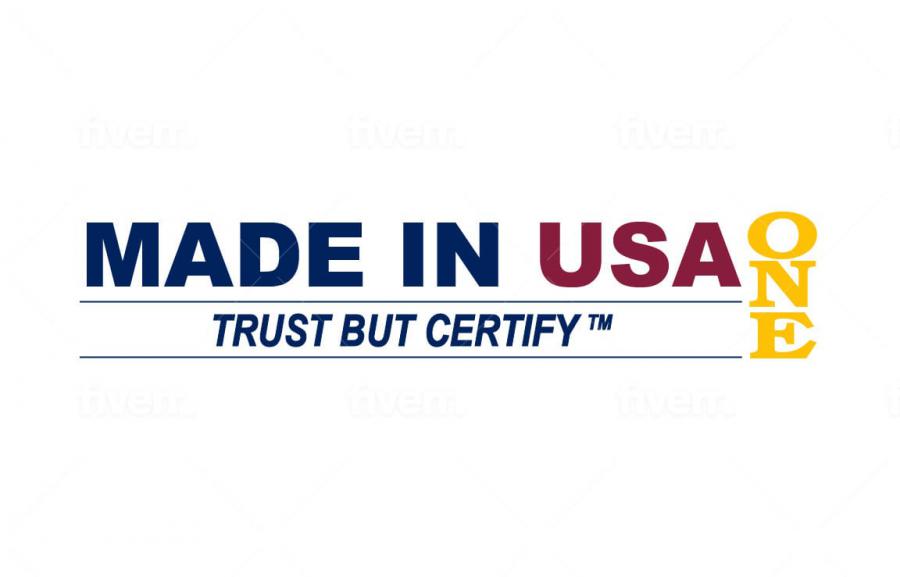
MADE in USA vs MADE in AMERICA Clarification
Distinguishing 'MADE IN USA' from 'MADE IN AMERICA' to ensure labeling accuracy and uphold consumer trust.
WASHINGTON, DC, USA, May 14, 2024 /EINPresswire.com/ -- Clarifying Certification: Distinguishing Between 'MADE IN USA' and 'MADE IN AMERICA'
In today's highly globalized market, understanding the origin of products is crucial for consumers and manufacturers alike. MADE IN USA ONE is committed to elucidating the significant differences between "MADE IN USA" and "MADE IN AMERICA." This effort aims to ensure that consumers are accurately informed and that products align with specific manufacturing standards and legal frameworks.
Defining 'MADE IN USA' Certification
The "MADE IN USA" certification, regulated by the Federal Trade Commission (FTC), mandates that a product must be a"qualified statement" and manufactured within the United States. This includes the product's significant parts, processing, and labor. The standard ensures the product contains a validated percentage or minimal or no foreign content. Compliance with this certification not only supports the U.S. economy by retaining and creating jobs but also reassures consumers about the quality and authenticity of the product.
The Ambiguity of 'MADE IN AMERICA'
In contrast, "MADE IN AMERICA" is a broader, more ambiguous term that can refer to products made anywhere in the Americas, including North, Central, and South American countries. This wide-ranging label can be misleading, as it may encompass products manufactured in countries with different standards of quality and labor practices compared to those upheld in the U.S.
Implications for Economic Policies and International Trade
The distinction between these labels is not merely semantic but is deeply entwined with economic policy and international trade. Recent U.S. administrations have emphasized strengthening the U.S. economy through various initiatives and executive orders focusing on boosting domestic manufacturing, infrastructure, and job creation.
Executive Orders and Initiatives:
Buy American Act: Reinforces the use of U.S.-made products in federal procurement, thereby fostering domestic production.
Build Back Better Plan: This plan proposes substantial investments in American infrastructure and clean energy to revitalize the U.S. industrial base.
Five New Executive Orders: These orders specifically target improvements in federal procurement policies to ensure that the government’s purchasing power is used to buy products made in the USA, enhancing the creation of U.S. jobs and supporting U.S. manufacturing sectors.
Navigating Global Trade Agreements
Understanding the nuances of "MADE IN USA" becomes particularly significant in the context of major trade agreements:
NAFTA and USMCA: These North American agreements involve the U.S., Canada, and Mexico and aim to eliminate barriers to trade and investment.
CAFTA-DR: This agreement includes the U.S. and six Central American countries. It promotes economic integration by reducing tariffs and improving regional trade.
Mercosur: A South American trade bloc that facilitates economic cooperation among its member countries, including Argentina, Brazil, Paraguay, and Uruguay.
Why Clarity Matters
Accurate labeling influenced by these distinctions allows consumers to make informed decisions that align with their values, such as supporting the U.S. economy and ensuring high standards of product quality and labor practices. For manufacturers, precise labeling is about compliance with legal standards and building consumer trust and loyalty.
MADE IN USA ONE champions rigorous certification processes and public education to advocate for the integrity and transparency of products manufactured within the U.S. By providing clear, unambiguous labeling, MADE IN USA ONE upholds the highest standards of quality for U.S.-manufactured products, contributing significantly to the U.S. economy and ensuring consumer confidence in the authenticity of their purchases.
Conclusion
The accurate use of "MADE IN USA" and a move away from the ambiguous "MADE IN AMERICA" are more than marketing strategies; they are essential components of a broader plan to enhance economic security, support national manufacturing, and ensure that consumers are fully informed about the origins and quality of the products they buy. As global trade evolves and U.S. policies adapt, maintaining clarity in product labeling will continue to play a crucial role in supporting the U.S. economy.
About MADE IN USA ONE
MADE IN USA ONE supports and promotes U.S. manufacturing and production through rigorous certification processes and public education. We are committed to upholding American-made products' highest transparency and quality standards.
The distinctions between "MADE IN USA" and "PRODUCT OF USA" are pivotal in a global trade context influenced by agreements such as NAFTA (North American Free Trade Agreement), USMCA (United States-Mexico-Canada Agreement), and CAFTA-DR (Central American Free Trade Agreement-Dominican Republic). These agreements facilitate trade and define economic relationships between the U.S. and other countries in North and Central America, often creating complexities in product origin that can confuse consumers.
NAFTA and USMCA: These agreements involve North America, specifically the countries of Mexico, Canada, and the United States. They aim to reduce trading costs, increase business investment, and help North America be more competitive in the global marketplace.
CAFTA-DR: This agreement includes the United States and six Central American countries: Costa Rica, the Dominican Republic, El Salvador, Guatemala, Honduras, and Nicaragua. It promotes stronger trade and economic ties through reduced tariffs and improved market access.
The equivalent trade bloc in South America is Mercosur (Southern Common Market), which includes Argentina, Brazil, Paraguay, and Uruguay. This bloc fosters economic cooperation by facilitating free trade and the movement of goods, people, and currency among its member countries.
Footnote: As they navigate a complex global marketplace, it is essential for both consumers and manufacturers to understand these labeling distinctions within the broader context of international trade agreements and domestic economic policies.
Adam Reiser
MADE IN USA ONE LLC
+1 561-789-1139
email us here
EIN Presswire does not exercise editorial control over third-party content provided, uploaded, published, or distributed by users of EIN Presswire. We are a distributor, not a publisher, of 3rd party content. Such content may contain the views, opinions, statements, offers, and other material of the respective users, suppliers, participants, or authors.




